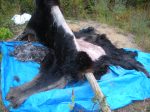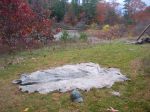Here are some arrows I made recently. The padded one is for bopping deer on the butt. That way I can practice hunting all year long as there is no season on harassing wildlife. 




Archive for January, 2011
Primitive Arrows
Posted in Primitve Hunting, tagged pine pitch adhesive, primtive arrows, stone points on January 29, 2011| 4 Comments »
Sit Spot
Posted in Nature Awareness, tagged kamana naturalist training program, practical tracking, sit spot on January 28, 2011| 1 Comment »
 I’ve had many sit spots over the years and for some reason this one might be my favorite. It is in a little park in the middle of Fort Worth, TX. The view is just right and I’m near a trail but hidden from it. Having the pond there attracts a lot of wildlife but more than anything, this spot just feels really good. Sometimes it seems like a certain sit spot has everything but it never feels quite right. This is a good one.
I’ve had many sit spots over the years and for some reason this one might be my favorite. It is in a little park in the middle of Fort Worth, TX. The view is just right and I’m near a trail but hidden from it. Having the pond there attracts a lot of wildlife but more than anything, this spot just feels really good. Sometimes it seems like a certain sit spot has everything but it never feels quite right. This is a good one.
My favorite skill to practice right now is the art of trailing. This is the skill of recognizing a fresh trail and following it to the animal. It is an amazing skill and seems unbelievable at times which makes it so fun to learn. When I start to see trails and tracks that before wouldn’t have caught my eye it is very exciting. I think this skill pushes the core of human potential. We evolved to track and process millions of bits of information through our senses and synthesize it into feelings and meanings all in a glance. Everyone needs to feel the joy of this taking place in their brains because our species worked hard for thousands of years to develop this ability.
My routine for practicing trailing is to make a clear track, then walk in a big loop back to this track. Then I follow the trail very meticulously looking for every single track and disturbance. Once I make it back to the start I follow the trail again but this time I keep my head up and look as far down the trail as I can and move as fast as I can along the trail while still seeing the tracks. This last part is the goal and eventually I’ll abandon the first meticulous pass. This  is the exercise recommended in the book Practical Tracking. A great book about learning to trail dangerous animals in Africa and North America. Can you see the trail in this picture? It follows the right side of the road for a bit the move across to the left side.
is the exercise recommended in the book Practical Tracking. A great book about learning to trail dangerous animals in Africa and North America. Can you see the trail in this picture? It follows the right side of the road for a bit the move across to the left side.
Small arrow head
Posted in Primitve Hunting on January 27, 2011| Leave a Comment »
A Kincentric View of Nature
Posted in Land Use Ethic on January 27, 2011| Leave a Comment »
Here is another excerpt from Tending the Wild:
“Although native ways of using and tending the earth were diverse, the people were nonetheless unified by a fundamental land use ethic: one must interact respectfully with nature and coexist with all life-forms. This ethic transcended cultural and political boundaries and enabled sustained relationships between human societies and California’s environments over millennia. The spiritual dimension of this ethic is a cosmology that casts humans as part of the natural system closely related to all life-forms. In this view, all non-human creatures are ‘kin’ or ‘relatives,’ nature is the embodiment of the human community, and all of nature’s denizens and elements – the plants, the animals, the rocks, and the water – are people. As ‘people,’ plants and animals possessed intelligence, which meant that they could serve in the role of teachers and help humans in countless ways – relaying messages, forecasting the weather, teaching what is good to eat and what will cure an ailment.’
This view of other life as related, equal, and highly intelligent is what Enrique Salmon (Raramuri) calls a ‘kincentric’ view of the world.”
Non-returning boomerangs
Posted in Primitve Hunting, tagged boomerang, hopi stick, non-returning boomerang, primtive hunting, rabbit stick on January 27, 2011| 3 Comments »
Non-returning boomerangs or hunting boomerangs are said to be the preferred small game hunting weapon in open grassland areas. Even over the bow and arrow. This is because they can fly for over 200 yards in a straight line floating at 3′ above the ground. And they are very deadly.
I’ve only made these two so far but I plan on making many more. Like so many of these primitive skills simplicity meets a very high level of complexity. What is simpler than throwing a stick at a rabbit for food? But to make one of these fly in a straight line for 200 yards is a real feat of aeronautical engineering.
There are a few important parts to making one of these. One is that you want the heavest wood available. I used Red Oak for the first one and Live Oak for the second one. The Live Oak is heavier and works much better. In southern California Dunn Oak is the preferred wood.
 You also can’t fake the curve. It has to be from a branch growing in that shape or a green branch that is heated and bent. If the curve is carved out of a board or a thicker log then it will cheat the grain and end up breaking. Also the curve needs to be sharp enough so that the boomerang doesn’t flip over as it starts to slow down. The final, important part is the cross section. I’m still not sure how it should be but I know its important. Some say lenticular, others say flat on bottom curved on top, and others swear that it should be flat with a slight curve at the edge. I have yet to find my preference.
You also can’t fake the curve. It has to be from a branch growing in that shape or a green branch that is heated and bent. If the curve is carved out of a board or a thicker log then it will cheat the grain and end up breaking. Also the curve needs to be sharp enough so that the boomerang doesn’t flip over as it starts to slow down. The final, important part is the cross section. I’m still not sure how it should be but I know its important. Some say lenticular, others say flat on bottom curved on top, and others swear that it should be flat with a slight curve at the edge. I have yet to find my preference.
Use Nature
Posted in Land Use Ethic on January 27, 2011| 3 Comments »






